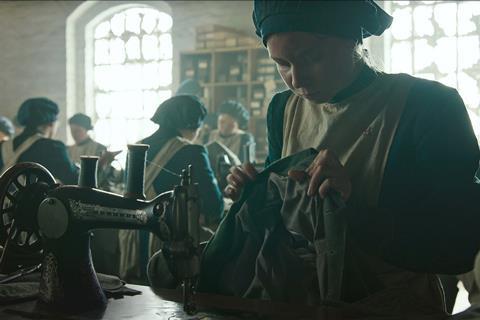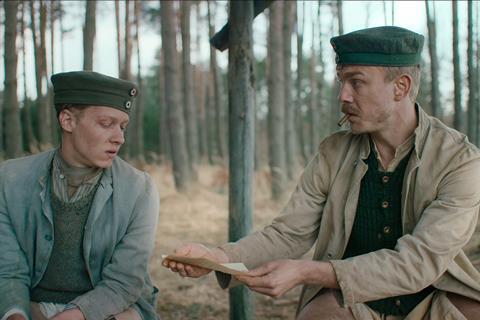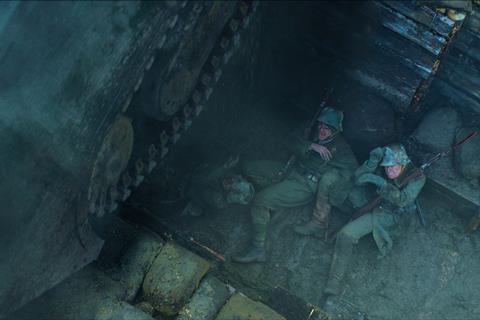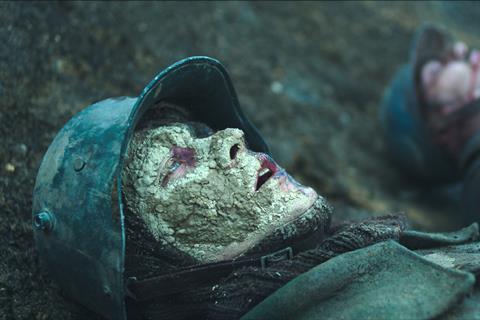First World War drama All Quiet On The Western Front has stormed the Bafta and Oscar nominations in multiple categories. Director Edward Berger tells Screen about his choices in four of the film’s key sequences.
Published in 1928, Erich Maria Remarque’s landmark anti-war tale All Quiet On The Western Front is the biggest-selling German novel of all time. Filmed in 1930 and again in 1979, the book had never been adapted in German by a German filmmaker.
“I read it when I was 15, then again when I was 23, and it stayed with me,” says Edward Berger, director of Deutschland 83 and the TV Bafta-winning miniseries Patrick Melrose. “But I never had the idea or the audacity to make it.”
When producer Malte Grunert suggested a new version to Berger, the combination of the rise of the far-right across the globe, inflammatory language in his homeland regarding former chancellor Angela Merkel and his daughter’s love for the book convinced him to make it.
“I felt it was the right time to tell this from its German perspective,” says Berger. “In Germany, everything is ridden with guilt and shame and a responsibility towards history. I feel it on my shoulders every day, and I thought if you were to make a film with that inside of you, it’s going to feel very different than an American or British film. And that might be worth sharing with other countries.”
Berger’s instinct proved correct, with the Netflix film earning a record-equalling 14 Bafta nominations, including best film, director and film not in the English language — and nine Oscar nods including best picture, adapted screenplay and international feature. Taking a break from shooting his latest film Conclave in Rome, Berger talks through four pivotal scenes. There are spoilers.
The machinery of war
The scene: In the film’s opening montage, Heinrich (Jakob Schmidt), a young German soldier, is gunned down on the battlefield. His uniform is recycled, washed, and repaired before being handed to another recruit.

Edward Berger: “It’s emblematic for the big theme of the movie, which is the machinery of war and how you’re chewed up in it. This scene is not in the book, but we tried to find a visual expression of it, so we thought of this opening montage of how the uniform of the person you think is going to be our hero, and is going to lead us through the movie, is recycled and used on the next soldier. Things like that happen today. I read in the paper that Russian conscripts inherit the uniforms of their dead comrades. And so that uniform is whirled and cleaned and ends up in these sewing machines, which are going in unison. That turns into the sound of machine guns and the wheel of a truck, showing how these young men are mauled up in this machinery of war.
“With the opening battle, we wanted to immediately set the tone of being very subjective, and in the shoes of the supposed hero, so we go very close to him. It was a very complicated scene to film. It is three shots. One, from the sky, coming through the clouds, seeing an abstract painting of bodies on the ground. We do not hear the battle. We hear the sounds of nature. Then we come down, see the battle, and there’s an explosion where we are right in the trench.
“We approach Heinrich with a piece of equipment called the Stabileye camera. We hook it onto a crane and climb up with this kid, out of the trench, then unhook the camera and run with him across the battlefield until he gets shot. It felt very important to us that we are running with him, experiencing time with him, and not excluding any second of this experience.”
Letter from home
The scene: Away from the front, Paul Bäumer (Felix Kammerer) and Kat (Albrecht Schuch) visit a latrine. As they go about their business, Paul reads aloud a letter from Kat’s wife, which details her daily life before making mention of their dead child.

BERGER: “In the book, there’s a chapter of Paul going home and feeling he doesn’t belong anymore. And people can’t relate to him because his experiences are very different. We couldn’t include that, because we included the signing of the Armistice in Compiegne, and that automatically puts that part of the movie at the last week of the war. But it is a very famous scene and one I would have missed, that feeling at least. So the scene on the latrine, taking a shit, which is the most normal activity you can have, we included to show there’s no way of returning to normalcy for them.
“The scene came from a note from Netflix who said it would be nice to have another moment between these characters not in battle. So I started reading hundreds of letters in an online archive, letters from the time, by soldiers at the front and their families at home. I found this letter, and it didn’t mention a dead son, but the language of the sugar and the jam and whatever she’s sending, is verbatim.
“It’s a very quiet scene, so the camera is very quiet; it’s two-and-a-half, three minutes of a two-shot of them sitting and reading and it was driven by their performance. Paul reads the letter and then the death of the child comes in and it’s a shock to him. Kat’s face, as he listens to this letter, was the most beautiful thing, and we were like, ‘Let’s just hold the shot and let these actors do the work for us.’ And they did.”
Tank warfare
The scene: During one attack on the French lines, the German soldiers must contend with arguably the most terrifying invention of the First World War — tanks.

BERGER: “These things were very slow. They were more to instil fear. The whole movie was guided by Paul’s subjectivity, to put the audience into his shoes. That’s why we filmed the movie with one camera only. We put the camera either on Paul’s face, to try to see what he feels inside, or it’s his POV, what he sees. In this case, it’s the tanks coming through the fog, which, again, is the machinery of war.
“They won’t stop. They will literally drive over people. We wanted the audience to experience what Paul experiences. The utter horror of the tank driving over you, and the fear of death that must creep into you. Putting the audience into the horrific experience of what it must have felt like seeing these metal UFOs coming out of some ominous yellow fog, which is also mysterious. It’s not gas, gas wasn’t coloured, but we gave the fog a colour to make it otherworldly. It’s also maybe a reference to Apocalypse Now, which has a famous yellow fog scene.
“All the battle scenes were incredibly complex. We shot on an ex-Soviet Union airfield in the Czech Republic. At some point, my cinematographer James Friend said in a meeting, ‘We’ve all shot battle scenes before.’ I’ve never even blown up a car on screen before — I’ve made very simple movies. So it was a big challenge, but that’s part of the reason why I wanted to make it.
“We know we can’t have a tank drive over a trench because it’s going to collapse, especially with people underneath, so we built a section of the trench separate from the battlefield, with fortified walls, because we needed the camera POV of Paul underneath it, and we needed to look up at the tank. Everyone was involved: SFX, stunts, camera, production design.
“James and I storyboarded every frame of these battles, and we kept redrawing. Everything needed to be planned because we didn’t have much time or money. The film was shot in 52 days and the tank battle scene probably took two weeks of that, because you can only shoot 40 seconds a day. Every day, driving to a set, sheer panic arose within me that we wouldn’t be able to achieve it. But these storyboards gave us a backbone. Without them, I probably would have broken or gone insane because that way we were able to focus on one step at a time, one shot at a time.”
Close combat
The scene: During one skirmish, Paul finds himself in a shell crater. But he is not alone — there is also a French soldier. He pounces on the soldier and stabs him repeatedly. But the man does not die immediately and Paul has a crisis of conscience, tending to his wounds and promising to tell his wife what happened.

BERGER: “Part of the decision to make the film was my daughter. I wasn’t really looking for a German movie, I was looking for some wonderful American or English movie to do. I discussed [the project] at the dinner table and my daughter, who was then 17, whips around and says, ‘I’ve just read it in school. I cried so many times. You have to make it.’ In the same breath she says, ‘There’s this scene in the crater where he kills a Frenchman, and it was the worst thing I’ve ever read.’ And I thought, ‘Oh God, now I have to do right by this scene and not screw it up.’
“We had built a big crater, hip deep in water, and it made it complicated to film. The day we rehearsed on set, the scene took 11 minutes. And we have scheduled a day and a half to film it. It’s three pages in the script; usually three pages is three minutes. But it felt great the way those two did it. The French guy was a Czech stuntman and did it beautifully. And Felix was heartbreaking. Then the AD rushes up and says, ‘Can you simplify it? We’re going to take four days to shoot this.’ I knew I had to shut one ear, the right one where the AD says, ‘Can you simplify it?’ Or the left one where my daughter is saying, ‘The scene is great.’ I listened to my daughter. We ended up taking four days and had to cut some other stuff to make it possible.
“The conceit of it is a young man realising he’s lost his soul and become a killer to survive. You must kill, otherwise you’re going to be killed. He has a moment to stop and looks this young guy in the eye and realises, ‘He’s just like me. He’s another human being. He’s not the enemy. He has a mother, he has a wife, he has a kid.’ And that sinks into him.
“Again, we tried to be very subjective and to be in Paul’s shoes and make you go through it. Even though the scene is cut up, we let it play out in real time, to make it as insufferable for you as it is for Paul. Nothing is spared.
“We shot uninterrupted takes of 10 minutes, and Felix lived through it every single time. He gave it everything. He sobbed, he ate the mud, he crawled through the water. And he wiped the soldier’s face with so much love. It was an idea Felix had, of cleaning the soldier’s face. I thought that was a beautiful idea.”
























No comments yet